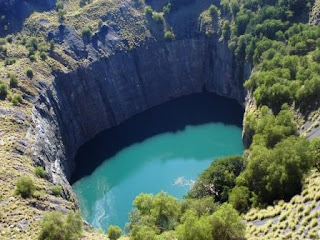This Christmas i was in South Africa, touring few of the beautiful places of African Continent. Kimberly was one of them. I thougt, i should share the interesting facts about Kimberly and especially about BIG HOLE there.

150 years ago, the site of the Big Hole was a featureless, flat-topped hill. Then word spread that diamonds had been discovered. Soon thousands of prospectors, armed with nothing more than picks, shovels and hope, descended on Kimberley and created the largest hand-dug excavation in the world.
Digging commenced at the Kimberley Mine site in 1871. By the time mining ended on 14 August 1914, the mine had yielded 2,722 kilograms of diamonds, extracted from 22,5 million tons of excavated earth.
Digging commenced at the Kimberley Mine site in 1871. By the time mining ended on 14 August 1914, the mine had yielded 2,722 kilograms of diamonds, extracted from 22,5 million tons of excavated earth.
The equipment used to process the diamond ore was housed in the Pulsator Building. Visitors can see the old jigging machines and grease tables specially designed to extract the diamonds from the ore.
Although the techniques of mining and extracting diamonds have vastly improved, modern diamond mining still uses the same basic methods that were developed in Kimberley.
The techniques of underground diamond mining were pioneered at Kimberley.The mine revealed to geologists, for the first time, that the primary deposits of diamonds were ancient volcanic pipes. Until Kimberley yielded its secrets, prospectors assumed that diamonds were found only in rivers - as was the case in India and Brazil. 

After the great Diamond Rush of 1871, Kimberley became the world's largest diamond producer. This wealth ushered in South Africa's Industrial Revolution. The Underground Mine Experience enables visitors who enter a recreation of a mine shaft of the period to experience the perilous 19th century mining conditions.
It is believed that in early 1867 when curious children picked up a shiny stone on the banks of the Orange River. This stone, intended for their collection of pretty pebbles, proved to be a diamond. The fascinating story of its discovery changed the destiny of the entire region.
It is believed that in early 1867 when curious children picked up a shiny stone on the banks of the Orange River. This stone, intended for their collection of pretty pebbles, proved to be a diamond. The fascinating story of its discovery changed the destiny of the entire region.
The Real Diamond Display is housed in a vault, specially constructed for the Big Hole facility. Among the gems on display is the famous 616 - named for its carat size. This is the largest uncut octahedron diamond in the world. Appropriately, the shiny little stone found on the banks of the Orange River in 1867.


The largest single diamond crystal in the world at 616 carats
Behind these beautiful and precious diamonds there are lots of miserable lifes, Like an epic story, the history of diamonds in South Africa contains episodes of anguish and tragedy. After walking hundreds of miles from their villages around Southern Africa, many workers were faced with a hard existence in the compounds that were constructed to keep them productive - and prevent theft.
School and university groups will find the exhibition centre at Big Hole, Kimberly both fascinating and educational. It covers topics such as history, chemistry, geology and engineering.
It's a splendid & life time experience visiting Kimberly.




